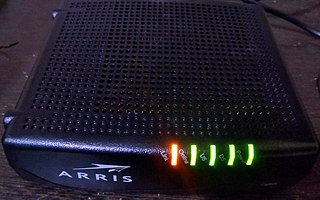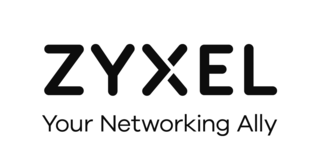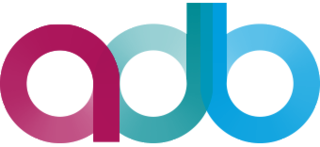
Wireless broadband is telecommunications technology that provides high-speed wireless Internet access or computer networking access over a wide area. The term comprises both fixed and mobile broadband.
In telecommunications, a customer-premises equipment or customer-provided equipment (CPE) is any terminal and associated equipment located at a subscriber's premises and connected with a carrier's telecommunication circuit at the demarcation point ("demarc"). The demarc is a point established in a building or complex to separate customer equipment from the equipment located in either the distribution infrastructure or central office of the communications service provider.

A cable modem is a type of network bridge that provides bi-directional data communication via radio frequency channels on a hybrid fibre-coaxial (HFC), radio frequency over glass (RFoG) and coaxial cable infrastructure. Cable modems are primarily used to deliver broadband Internet access in the form of cable Internet, taking advantage of the high bandwidth of a HFC and RFoG network. They are commonly deployed in the Americas, Asia, Australia, and Europe.
The liberalization of Bangladesh's telecommunications sector began with small steps in 1989 with the issuance of a license to a private operator for the provision of inter alia cellular mobile services to compete with Bangladesh Telegraph and Telephone Board (BTTB), the previous monopoly provider of telecommunications services within Bangladesh. Significant changes in the number of fixed and mobile services deployed in Bangladesh occurred in the late 1990s and the number of services in operation have subsequently grown exponentially in the past five years.
Voice over Internet Protocol (VoIP), also called IP telephony, is a method and group of technologies for the delivery of voice communications and multimedia sessions over Internet Protocol (IP) networks, such as the Internet. The terms Internet telephony, broadband telephony, and broadband phone service specifically refer to the provisioning of communications services over the Internet, rather than via the public switched telephone network (PSTN), also known as plain old telephone service (POTS).
Wireless local loop (WLL), is the use of a wireless communications link as the "last mile / first mile" connection for delivering plain old telephone service (POTS) or Internet access to telecommunications customers. Various types of WLL systems and technologies exist.

Internet access is the ability of individuals and organizations to connect to the Internet using computer terminals, computers, and other devices; and to access services such as email and the World Wide Web. Internet access is sold by Internet service providers (ISPs) delivering connectivity at a wide range of data transfer rates via various networking technologies. Many organizations, including a growing number of municipal entities, also provide cost-free wireless access and landlines.

IEEE 802.20 or Mobile Broadband Wireless Access (MBWA) was a specification by the standard association of the Institute of Electrical and Electronics Engineers (IEEE) for mobile broadband networks. The main standard was published in 2008. MBWA is no longer being actively developed.

Worldwide Interoperability for Microwave Access (WiMAX) is a family of wireless broadband communication standards based on the IEEE 802.16 set of standards, which provide physical layer (PHY) and media access control (MAC) options.

Internet Protocol television (IPTV) is the delivery of television content over Internet Protocol (IP) networks. This is in contrast to delivery through traditional terrestrial, satellite, and cable television formats. Unlike downloaded media, IPTV offers the ability to stream the source media continuously. As a result, a client media player can begin playing the content almost immediately. This is known as streaming media.

Telekom Malaysia Berhad is a Malaysian telecommunications company founded in 1984. Beginning as the national telecommunications company for fixed line, radio and television broadcasting services, it has evolved to become the country's largest provider of broadband services, data, fixed-line, pay television and network services. TM ventured into the Long Term Evolution (LTE) space with the launch of TMgo, its first 4G offering. TM's 850 MHz service was rebranded as unifi Mobile in January 2018.

StarHub Limited, most commonly known as just Starhub, is a Singaporean multinational telecommunications conglomerate and one of the major telcos operating in the country. Founded in 1998, it is listed on the Singapore Exchange (SGX).
The next-generation network (NGN) is a body of key architectural changes in telecommunication core and access networks. The general idea behind the NGN is that one network transports all information and services by encapsulating these into IP packets, similar to those used on the Internet. NGNs are commonly built around the Internet Protocol, and therefore the term all IP is also sometimes used to describe the transformation of formerly telephone-centric networks toward NGN.

Zyxel Communications Corporation, a subsidiary of Unizyx Holding Corporation, is a Taiwanese multinational broadband access solutions provider headquartered in the Hsinchu Science Park, Taiwan. With three research centers, four regional headquarters, and 35 branch offices located across the major continents, Zyxel Communications has established an internationally recognized reputation and extended businesses to 150 markets around the world.
A residential gateway is a small consumer-grade gateway which bridges network access between connected local area network (LAN) hosts to a wide area network (WAN) via a modem, or directly connects to a WAN, while routing. The WAN is a larger computer network, generally operated by an Internet service provider.
Wireless Application Protocol (WAP) is a technical standard for accessing information over a mobile wireless network. A WAP browser is a web browser for mobile devices such as mobile phones that use the protocol. Introduced in 1999, WAP achieved some popularity in the early 2000s, but by the 2010s it had been largely superseded by more modern standards. Almost all modern handset internet browsers now fully support HTML, so they do not need to use WAP markup for web page compatibility, and therefore, most are no longer able to render and display pages written in WML, WAP's markup language.
DVB-RCS is an acronym for Digital Video Broadcasting - Return Channel via Satellite or. It is a specification for an interactive on-demand multimedia satellite communication system formulated in 1999 by the DVB consortium.
The Broadband Forum is a non-profit industry consortium dedicated to developing broadband network specifications. Members include telecommunications networking and service provider companies, broadband device and equipment vendors, consultants and independent testing labs (ITLs). Service provider members are primarily wire-line service providers (non-mobile) telephone companies.
2Wire, Inc., was a home networking Customer Premises Equipment (CPE) manufacturer that provided telecommunications companies with hardware, software, service platforms, and remote CPE management systems. The company was headquartered in San Jose, California, in the Silicon Valley. The company had employed approximately 1,600 employees globally, including 550 in R&D, sales and administration, 450 in customer care and 600 agency employees in five U.S. offices and an additional nine offices around the world by July 2010. The 2Wire HomePortal residential gateways were distributed by broadband service providers such as AT&T, Embarq, windstream and Qwest in the United States, Bell in Canada, Telmex in Mexico, BT Group in the United Kingdom, Telstra in Australia and SingTel in Singapore. In July 2010, Pace plc of the United Kingdom agreed to buy 2Wire for $475m (£307m).

Advanced Digital Broadcast (ADB) is a company which provides software, system and services to pay-TV and telecommunication operators, content distributors and property owners around the world. The company specializes also in the development of digital connectivity devices such as set-top boxes and residential gateways.










